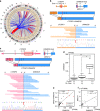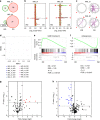Integrated exome and RNA sequencing of dedifferentiated liposarcoma
- PMID: 31831742
- PMCID: PMC6908635
- DOI: 10.1038/s41467-019-13286-z
Integrated exome and RNA sequencing of dedifferentiated liposarcoma
Erratum in
-
Publisher Correction: Integrated exome and RNA sequencing of dedifferentiated liposarcoma.Nat Commun. 2020 Feb 19;11(1):1024. doi: 10.1038/s41467-020-14680-8. Nat Commun. 2020. PMID: 32075980 Free PMC article.
Abstract
The genomic characteristics of dedifferentiated liposarcoma (DDLPS) that are associated with clinical features remain to be identified. Here, we conduct integrated whole exome and RNA sequencing analysis in 115 DDLPS tumors and perform comparative genomic analysis of well-differentiated and dedifferentiated components from eight DDLPS samples. Several somatic copy-number alterations (SCNAs), including the gain of 12q15, are identified as frequent genomic alterations. CTDSP1/2-DNM3OS fusion genes are identified in a subset of DDLPS tumors. Based on the association of SCNAs with clinical features, the DDLPS tumors are clustered into three groups. This clustering can predict the clinical outcome independently. The comparative analysis between well-differentiated and dedifferentiated components identify two categories of genomic alterations: shared alterations, associated with tumorigenesis, and dedifferentiated-specific alterations, associated with malignant transformation. This large-scale genomic analysis reveals the mechanisms underlying the development and progression of DDLPS and provides insights that could contribute to the refinement of DDLPS management.
Conflict of interest statement
The authors declare no competing interests.
Figures





References
-
- Weiss SW, Rao VK. Well-differentiated liposarcoma (atypical lipoma) of deep soft tissue of the extremities, retroperitoneum, and miscellaneous sites. A follow-up study of 92 cases with analysis of the incidence of “dedifferentiation”. Am. J. Surg. Pathol. 1992;16:1051–1058. doi: 10.1097/00000478-199211000-00003. - DOI - PubMed
Publication types
MeSH terms
Substances
LinkOut - more resources
Full Text Sources

